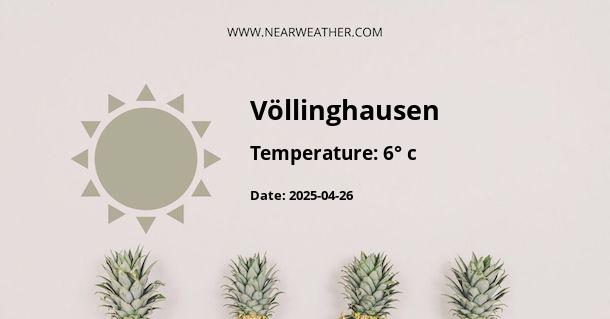Climate and Weather Overview of Völlinghausen, Germany
Völlinghausen, a location in Germany, experiences a temperate climate that is characterized by four distinct seasons, varying temperatures, and consistent precipitation. In Germany, the climate can vary considerably from region to region, and specific local factors can influence the weather experienced in Völlinghausen. Understanding these climatic conditions is essential for residents, tourists, and businesses operating in the area.
Geographical Influences on Völlinghausen's Climate
In Germany, the weather is primarily affected by its location within the temperate zone and its exposure to maritime influences from the west and continental influences from the east. The country's varied topography, with its lowlands in the north, the uplands in the center, and the Bavarian Alps in the south, also plays a crucial role.
While Völlinghausen itself may not have such extremes in topography, its proximity to larger natural and geographic features will impart subtle shifts in climate compared to other regions in Germany.
Seasonal Climate Patterns in Völlinghausen
Spring
Spring in Völlinghausen sees gradually increasing temperatures with a mixture of sunshine, occasional showers, and some windy days. March typically starts with cooler temperatures that warm up through May. During this time, the surroundings come to life with blossoming flora.
Summer
Summers are generally warm but not excessively hot, with July being the warmest month. The climate can be moderately humid, leading to thunderstorms and heavy downpours at times. The long daylight hours make summer an ideal season for outdoor activities.
Autumn
Autumn witnesses a decline in temperatures starting from September, with October and November being progressively cooler. The season is known for its colorful foliage and is often accompanied by rainfall, which prepares the region for the colder months.
Winter
Winters can be cold, and while Völlinghausen may not experience the heavy snowfalls seen in the German Alps, it does receive some snow. January is the coldest month, and temperatures can drop below freezing. Frost and icy conditions are common.
Monthly Temperature and Precipitation Averages
To further break down the climate of Völlinghausen, let us examine the typical temperature ranges and precipitation levels by month. The following table showcases average statistics, although individual years can see significant variations.
| Month | Average High (°C) | Average Low (°C) | Precipitation (mm) |
|---|---|---|---|
| January | 3 | -2 | 46 |
| February | 4 | -1 | 39 |
| March | 8 | 1 | 50 |
| April | 13 | 4 | 46 |
| May | 18 | 8 | 59 |
| June | 21 | 11 | 72 |
| July | 23 | 13 | 80 |
| August | 23 | 13 | 75 |
| September | 19 | 10 | 54 |
| October | 14 | 6 | 45 |
| November | 8 | 2 | 49 |
| December | 4 | 0 | 55 |
Extreme Weather Events and Climate Change
Germany, like much of the world, is experiencing the impacts of climate change. Extreme weather events, such as heatwaves in summer and severe storms, have become more frequent. In Völlinghausen, this could translate into more volatile weather patterns, with potential for both more intense summer droughts and heavier winter precipitation.
"Climate change is increasingly making itself felt with heat waves, storms, and heavy rainfall" – German Meteorological Service (Deutscher Wetterdienst, DWD)
Long-Term Climate Trends
Examining long-term climate data is essential in understanding the future trajectory of the local climate. Current research and historical weather records suggest a gradual increase in average temperatures and a shift in precipitation patterns throughout Germany.
- Rising temperatures, leading to longer growing seasons and shifts in agricultural practices.
- Increased intensity and frequency of precipitation events, challenging urban drainage systems and flood management.
- Winters becoming milder, resulting in fewer days below freezing and reduced snowfall.
Adaptation and Preparedness
Given the trends and historical data, Völlinghausen, along with the rest of Germany, is actively adapting to these changes. This involves enhancing infrastructure resilience, implementing sustainable water management strategies, and designing buildings to cope with both higher temperatures and increased rainfall.
For individuals, staying informed through accurate weather forecasting and climate data is vital. Those involved in agriculture, tourism, and outdoor industries must pay particular attention to these changes to ensure sustainable practices.
Summary of Climate and Weather in Völlinghausen
To summarize, Völlinghausen experiences a temperate climate with a full range of seasons. Winters are cool to cold with occasional snow, and summers are warm and can sometimes experience heat waves. Precipitation is spread throughout the year but is slightly higher during the summer months with occasional thunderstorms.
With future climate change implications, Völlinghausen is expected to encounter warmer temperatures and more unpredictable weather patterns. These changes underline the importance of climate-aware planning and personal preparedness for the years ahead.
By understanding Völlinghausen's climate and weather patterns, one can appreciate the dynamic nature of this region's environment and prepare adequately for the seasonal variations that characterize life in this part of Germany.
A - Völlinghausen's Latitude is 51.466671 & Longitude is 8.200000.
A - Weather in Völlinghausen is 6° today.
A - Climate Conditions in Völlinghausen shows broken clouds today.
A - Humidity in Völlinghausen is 91% today.
A - Wind speed in Völlinghausen is 6.41 km/h, flowing at 90° wind direction. today.
